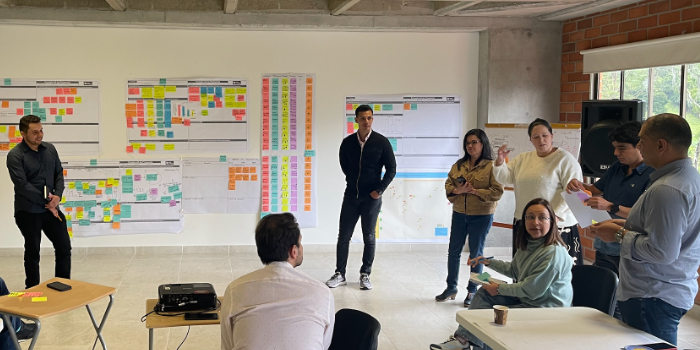
Transforming our business with Daily Management
CASE STUDY – By leveraging Daily Management (DM), Supergasbras was able to change its trajectory and add more value to the customer in a critical sector for society.
Words: Adriana Carneiro and Robson Gouveia
Supergasbras belongs to SHV Energy, a global distributor of off-grid energy, which provides 140,000 tons/month of Liquified Petroleum Gas (LPG) to approximately 11,000 dealers, 10 million families, and more than 50,000 industrial and commercial customers across Brazil. Overall, SHV Energy has twenty business units, with 17 filling plants, more than 40 warehouses, and a cylinder manufacturing and requalification plant.
With the various changes that the gas market has undergone in recent years, Supergasbras felt challenged to seek excellence in its operations to deliver more and better value to its customers. For this, they started a lean journey in 2017.
DEFINING PRIORITIES
The transformation began in a pilot unit with an implementation model for all of Brazil, which measures lean progress using maturity levels. The implementation in each business unit started with the operations and logistics areas and later expanded to support areas, such as sales, industrial facilities, finance, and HR.
Supergasbras’s improvement work is based on the implementation of six basic elements of a lean management system:
1) Performance Management (DM): a system of interlocking meetings to evaluate performance and prioritize the main issues to be solved.
2) Problem Solving: it structures the treatment of problems exposed by the daily management, using an 8-step scientific method known as A3.
3) Standardization: it ensures that the results stemming from the solutions highlighted in the A3 are sustained and expanded upon.
4) 5S: it helps to create standards in the work environment or process, making it safer, easier, and faster to identify abnormalities, in addition to helping to train the team in waste elimination.
5) Gemba: it develops the leader and teaches them to go to where the work takes place to confirm standards are being followed and/or develop people’s continuous improvement capabilities using open-ended questions.
6) Leader's standardized work: it helps leaders to structure and standardize their daily activities and saves them time in fulfilling those that are essential to sustain and develop a culture of continuous improvement.
To assess the progress of their journey, Supergasbras created a maturity scale going from 0 to 5, where level 1 corresponds to the beginning of the implementation in a pilot area of the unit and level 5 corresponds to the implementation of lean in all areas of the business unit and with full maturity.
Today, all business units have started their lean journey, although they are at different maturity levels.
DM AS THE FOUNDATION FOR EXECUTING STRATEGY
At Supergasbras, daily mangement begins with the deployment of the strategy as shown in the figure below:

It is by breaking down of company objectives that each area at each level clearly identifies its goals. Then, the control variables (metrics) that the area needs to measure to achieve its objectives are defined. It is important that these variables are very visual, directly tied to the goal, and able to highlight whether the team is achieving their goal or not (see example below).

These variables are placed in the performance chart that will be monitored in the daily management.

Another important point when setting up the daily management structure is to think about how the meetings intertwine at each level of the organization.
So, how does it work at Supergasbras?
MEETINGS AT DIFFERENT LEVELS
Supergasbras has established four level meetings in its daily management approach, each attended by the relevant team members.

The line sideboard is filled at an hourly cadence and by the operators themselves, who rely on the help chain to escalate problems whenever necessary.
The other boards are filled in daily, and the meeting is attended by the area leader and their direct reports. Together, they analyze the problems that occurred over the last 24 hours and/or those that were escalated from the level below.
The meetings are short and always take place in front of the board, usually with people standing around it. They need to have a clear agenda, discussing the last 24 hours and the next 24 hours of work. They are not meant to solve the problem, but rather to assess the performance gaps in the control variables, address actions to restore the desired performance, and/or define the actions that will be escalated to the next level (actions that the team does not have autonomy to carry out).
SOLVING PROBLEMS INVOLVING EVERYONE EVERY DAY
Daily management meetings always expose new problems that, depending on the level of complexity, are addressed using different approaches. For example, simple problems (called “Just do it”) that do not require a root-cause analysis can typically be solved by a simple action. More complex problems, however, require a more scientific approach to their resolution, through a tool that lean thinkers know as the A3.

Below are some of Supergasbras’s takeaways on daily management.

WHAT WE LEARNED… AND SOME TIPS FOR BEGINNERS
After a few years on the journey, Supergasbras has learned a lot. In the image below, the team highlights the key enablers that, in their experience, helped to stand up a successful daily management system.

What the company emphasizes is that lean tools and practices, while vital to success, are only 20% of the story. The remaining 80% lies in people development, engagement, and culture building.
To create the desired new behaviors, which ensure that problems are exposed and solved by everyone at all levels, it is necessary to provide a psychologically safe environment in which individuals feel free and encouraged to speak up, share their opinions and ideas, take risks, admit failures, learn from those failures, and have honest and open discussions.
Psychological safety and the constant fight against the fear of flapping up and dealing with problems is something that needs to be worked on with purpose, involving leaders and their teams in all the value streams of an organization.
Supergasbras understands that the road is long and that if they are to help people do their jobs better, achieve excellent results, deliver more value to customers, and positively contribute to society, they have to do it together with people at the front line, continuously learning from each other. If the below results are any indication, you can say they are on the right track!

THE AUTHORS


Read more


FEATURE – The author explores the relationship between kanban and improvement and discusses how using it can impact our lean transformation.


FEATURE - In the second article in his series, the author provides helpful tips for those interesting in bringing some Lean Thinking to their parenting, focusing on the first five years of a child's life.


CASE STUDY – Following a positive experience in manufacturing, this Colombian company brought lean to the rest of the organization. Its goal? To become a reliable partner for its clients in the national and international markets.


FEATURE - Without a solid accounting function no transformation can ever succeed. The author explains why lean accounting should be part of your strategy.

